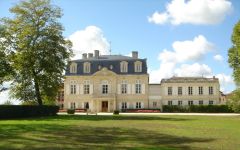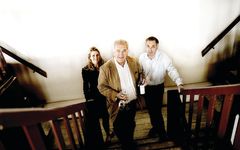Chateau Pontet-Canet 2011
-
Wine
Enthusiast -
James
Suckling -
Robert
Parker - Decanter
-
Wine
Spectator




Product Details
Your Rating
Somm Note
Winemaker Notes
Professional Ratings
-
Wine Enthusiast
So smooth, this is a rich, grandiose wine. Although it is full of black currant fruits and spice flavors, the texture is most impressive. Dusty tannins are integrated with juicy fruits seamlessly. The purest fruit flavors are allied to linear tannins in a precise yet generous way. The wine is evolving beautifully, but do not drink before 2020.
-
James Suckling
A wine with lots of ripe berries, verging on dried fruits. Full and chewy with ripe, round, chewy tannins. It needs lots of bottle age. A wine of steel. From biodynamically grown grapes, as always. Better than from barrel. Try in 2018.
-
Robert Parker's Wine Advocate
Deep garnet in color, the 2011 Pontet-Canet comes bounding out of the glass with exuberant notes of redcurrant jelly, warm cassis and blackberry pie plus touches of dried mint, mocha, smoked meats and yeast extract with a waft of pencil lead. Medium to full-bodied, the palate has bags of energy with lively red and black fruits and compelling mineral accents, finishing long with a provocative lift.
-
Decanter
Wild violets and black fruit nose, both exuberant and classic. It is a wonderfully elegant Pauillac with superb vineyard expression.
-
Wine Spectator
This cuts a broad swath, with prominent notes of espresso and ganache leading to the core of crushed plum and blackberry confiture. Lush, with the ganache edge joining a loamy hint to underscore the finish. Consistent with the barrel tasting, this shows more breadth than cut in the end.
Other Vintages
2022-
James
Suckling -
Jeb
Dunnuck - Decanter
-
Wine
Enthusiast -
James
Suckling -
Jeb
Dunnuck - Decanter
-
Robert
Parker
-
James
Suckling -
Robert
Parker -
Wine
Enthusiast -
Jeb
Dunnuck - Decanter
- Vinous
-
Robert
Parker -
Wine
Enthusiast -
James
Suckling - Decanter
-
Wine
Spectator -
Jeb
Dunnuck
-
Robert
Parker -
Wine
Enthusiast -
James
Suckling -
Jeb
Dunnuck - Decanter
-
Robert
Parker -
Wine
Enthusiast -
James
Suckling - Decanter
-
Wine
Spectator -
Jeb
Dunnuck
-
Wine
Enthusiast - Decanter
-
Robert
Parker -
Jeb
Dunnuck -
James
Suckling -
Wine
Spectator
-
James
Suckling -
Robert
Parker -
Wine
Enthusiast - Decanter
-
Jeb
Dunnuck -
Wine &
Spirits -
Wine
Spectator
-
James
Suckling -
Jeb
Dunnuck -
Wine
Enthusiast - Decanter
-
Robert
Parker -
Wine
Spectator
-
Wine
Enthusiast -
James
Suckling -
Robert
Parker -
Wine
Spectator
-
Wine
Enthusiast -
Robert
Parker -
James
Suckling -
Wine
Spectator -
Jeb
Dunnuck
-
Robert
Parker -
James
Suckling -
Jeb
Dunnuck -
Wine
Enthusiast -
Wine
Spectator
-
Jeb
Dunnuck -
Robert
Parker -
Wine
Enthusiast -
James
Suckling -
Wine
Spectator - Decanter
-
Robert
Parker -
Jeb
Dunnuck -
Wine
Enthusiast -
James
Suckling -
Wine
Spectator
-
Wine
Enthusiast -
Robert
Parker -
Wine
Spectator
-
James
Suckling -
Robert
Parker -
Wilfred
Wong -
Wine
Spectator -
Wine
Enthusiast
-
Jeb
Dunnuck -
Robert
Parker -
Wine
Spectator -
Connoisseurs'
Guide -
Wine
Enthusiast -
Wine &
Spirits
-
Wine
Spectator -
Wine
Enthusiast -
Jeb
Dunnuck -
Robert
Parker
-
Robert
Parker -
Wine
Spectator -
James
Suckling -
Wine
Enthusiast
-
Wine
Spectator
-
Wine
Spectator
-
James
Suckling -
Wine
Spectator -
Robert
Parker -
Wine
Enthusiast
-
Robert
Parker -
Wine
Spectator
-
Wine
Spectator -
Robert
Parker
-
Robert
Parker
-
Wine
Spectator





Jean Francois Pontet, Royal Master of the Horse in the early 18th Century, bought and consolidated several plots of land located northwest of Pauillac. Several years later, in 1750, his descendants bought neighboring vineyards in an area named "Canet", thus creating one of the largest estates in the entire Medoc. Chateau Pontet-Canet's topography and soil predestined it to produce great wine.
In 1865, the noted wine shipper Hermann Cruse acquired the chateau and its 120 hectares of vones. The Cruse dynasty provided the financial means to make one of the greatest wines in the Medoc. In 1975, Guy Tesseron, solidly implanted in the Cognac region, and owner of Lafon Rochet in St-Estephe, purchsed Pontet-Canet.
The family's avowed ambition is to pass on the history of Chateau Pontet-Canet and secure its future. Today, it is Guy Tesseron’s descendants who own the estate today: Alfred and his nieces Mélanie and Philippine, daughters of his late brother Gérard. Together, they have the same outlook. Alfred shares his vision of the estate with Mélanie, passing on to her its traditions, his outlook on vinegrowing and his passion for wine.
In 2004, the year of the first biodynamic trial which took place on 14 hectares, the wines were radiant, tighter and brighter. Alfred urged Jean-Michel to go further. The estate was fully converted to biodynamic agriculture. This decision became a commitment and a challenge, but also a first for a Médoc Classified Growth.
Since then, with each vintage comes new knowledge, furthering the understanding of the terroir in a profound way. The vine’s resistance to disease is better known today, the understanding of how different parcels behave has improved, always in keeping with biodynamic principles. It requires sincerity, pragmatism and transparency: in a nutshell, absolute dedication.
The wines of Chateau Pontet-Canet obtained organic certification from Ecocert and biodynamic certification from Biodyvin in 2010 and from Demeter in 2014.
A shared state of mind and a particular sensitivity are the key factors which have propelled Chateau Pontet-Canet to the summit of Bordeaux wines in recent years. They are the expression of the Tesseron family’s quiet determination to ensure continuity over the long term.
